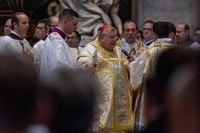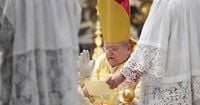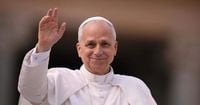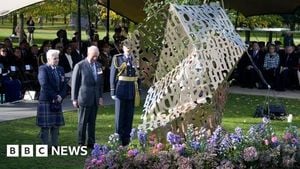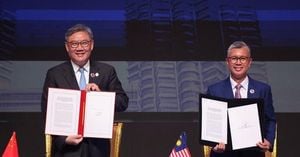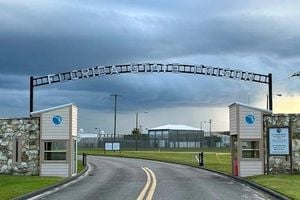On October 25, 2025, the cavernous nave of St. Peter’s Basilica was filled with the solemn chant of the traditional Latin Mass, marking a momentous occasion for Catholics devoted to the Church’s ancient liturgy. Hundreds of priests, lay faithful, and pilgrims from across the globe gathered at the Altar of the Chair to witness Cardinal Raymond L. Burke, a prominent American prelate and champion of the traditional rite, celebrate a pontifical Mass—a high Latin Mass reserved for bishops—during the annual Summorum Pontificum Pilgrimage to Rome. This year’s celebration, however, carried a special weight: for the first time since 2022, the Mass was held with the explicit approval of Pope Leo XIV, the newly elected and history-making first American pope.
The event was not merely a liturgical milestone; it was a symbol of renewed hope for traditionalist Catholics who had felt increasingly marginalized since Pope Francis imposed sweeping restrictions on the old Latin Mass in 2021. The pilgrimage itself, now in its 14th year, has long drawn the faithful "ad Petri Sedem"—to the See of Peter—to bear witness to their enduring attachment to the pre-Vatican II liturgy. This year, the pilgrimage began with a packed vespers service on October 24, presided over by Cardinal Matteo Zuppi at the Basilica of San Lorenzo in Lucina, and included a half-mile procession from the Basilica of Sts. Celso and Giuliano to St. Peter’s, culminating in the much-anticipated Mass celebrated by Cardinal Burke.
According to Catholic Connect, Pope Leo XIV personally authorized Cardinal Burke to celebrate the traditional Mass, responding to a formal request delivered during a private audience on August 22. The request, presented by Burke on behalf of more than 70 traditionalist groups, sought permission to hold the ancient rite at the heart of the Catholic Church. The pope’s response was swift: he phoned Cardinal Mauro Gambetti, the archpriest of St. Peter’s, and gave his blessing for the celebration. This act was interpreted by many as a gesture of pastoral inclusion and a sign that the new pontificate could usher in a period of greater dialogue and reconciliation within the Church.
For traditionalists, the moment was nothing short of historic. Rubén Peretó Rivas, a professor of medieval philosophy and an organizer of the pilgrimage, captured the mood succinctly, telling the Associated Press, “I’m very hopeful. The first signs of Pope Leo are those of dialogue and listening, truly listening to everyone.” The sense of relief and optimism was palpable, especially after years of feeling sidelined by the Vatican’s previous direction.
The roots of the so-called "liturgy wars" stretch back to the Second Vatican Council of the 1960s, which introduced sweeping reforms to Catholic worship. Chief among these was the shift from Latin to the vernacular and the repositioning of the priest to face the congregation. While the old Latin Mass—known formally as the 1962 Roman Missal—remained technically available, it became increasingly rare and was sometimes associated with groups openly critical of the council’s changes. Pope Benedict XVI, both before and during his pontificate, sought to heal these divisions. In 2007, he issued the Apostolic Letter Summorum Pontificum, granting priests broad freedom to celebrate the traditional liturgy and affirming the faithful’s right to request it. “What earlier generations held as sacred remains sacred and great for us too,” Benedict wrote, seeking to bridge the gap between tradition and reform.
That bridge, however, was partially dismantled in 2021 when Pope Francis issued Traditionis Custodes (“Guardians of the Tradition”), a decree aimed at regulating—and in many cases restricting—the celebration of the old Mass. Francis argued that the spread of the ancient liturgy had become a source of division and was being exploited by Catholics opposed to the reforms of Vatican II. Under the new rules, bishops were required to seek Rome’s approval for newly ordained priests to celebrate the old rite, and additional parish celebrations were subject to Vatican oversight. The effect, according to many traditionalists, was not unity but a deeper sense of alienation. “We are orphans,” said Christian Marquant, a French organizer of the pilgrimage, reflecting the sense of abandonment felt by many devotees.
Yet, as reported by the Associated Press and Catholic Connect, leaked Vatican documents in July 2025 cast doubt on the rationale for Francis’s crackdown. The documents suggested that a majority of bishops who responded to a 2020 Vatican survey were generally satisfied with the old Latin Mass and warned that imposing restrictions would “do more harm than good.” This revelation fueled calls for a more inclusive approach and bolstered hopes that Pope Leo XIV might chart a new course.
The 2025 Summorum Pontificum Pilgrimage was not only a liturgical event but also a powerful demonstration of unity and continuity. Joseph Shaw, president of Una Voce International—a federation representing Catholics devoted to the pre-Vatican II liturgy—expressed gratitude for the pope’s decision: “We are grateful to Pope Leo for his pastoral response to the request for a Traditional Mass in St. Peter’s. This celebration symbolises the unity with the Holy Father so desired by Catholics attached to the ancient rite of Mass.”
The return of the solemn pontifical Mass to St. Peter’s was also marked by a sense of personal connection between the pope and Cardinal Burke. In July, Pope Leo sent a letter of congratulations to Burke for his 50th anniversary of priestly ministry, a gesture widely interpreted as a sign of respect and goodwill. For his part, Burke has maintained that the beauty and reverence of the traditional Mass offer something unique to the Church’s spiritual life. James Rodio, a psychiatrist and father of three from Cleveland, Ohio, echoed this sentiment, telling the Associated Press, “I was just struck by the reverence and beauty and symbolism in action and gesture, and of course the content too.” Though Rodio’s parish in Cleveland had always maintained access to the Latin Mass, he described the frustration and sadness that followed Francis’s restrictions. “Behind it all, there was a sadness and sense that Francis didn’t understand them,” he said. “How could any organization have an approach for 16 or 17 centuries and then say it wasn’t valid anymore?”
In recent weeks, there have been other signs of a gentler approach. The Diocese of Cleveland, for instance, received a two-year extension to continue offering the Latin Mass at two diocesan churches. Rodio speculated that Pope Leo XIV may opt for quiet, incremental change rather than sweeping public pronouncements, suggesting, “My guess is Leo may try to do a lot by not doing a lot publicly.”
The pilgrimage concluded with a solemn closing Mass of Christ the King on October 26 at the Church of Santissima Trinità dei Pellegrini, capping three days of worship, processions, and renewed hope. While the future of the old Latin Mass remains an open question, the events of October 2025 have provided traditionalist Catholics with a powerful sign that their voices are being heard at the highest levels of the Church.
As the incense faded and the last notes of Gregorian chant echoed through St. Peter’s, many left with a sense that the Church, at least for now, is taking steps—however tentative—toward healing old wounds and embracing the richness of its diverse liturgical heritage.
